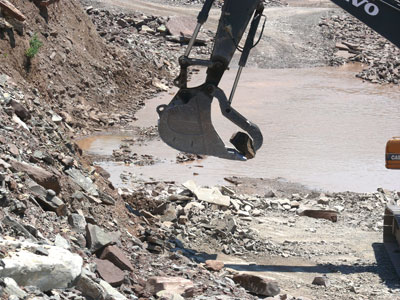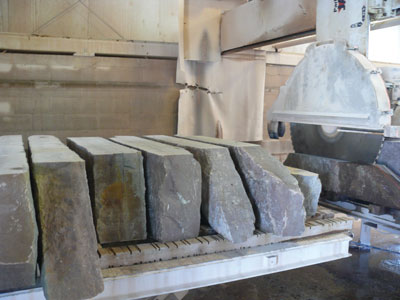
Features
Aggregates
Profiles
Crushing Margins
Upper Canada Stone meets high-end demands.
December 3, 2012 By Andrew Macklin
Having access to one of the richest deposits of multicoloured aggregate
in the world gives a company options for what products to produce.
Having access to one of the richest deposits of multicoloured aggregate in the world gives a company options for what products to produce. For Upper Canada Stone’s Madoc, Ont. quarries, that has meant distribution of some of the most premium rock products in Canada.
 |
|
| Producing high-end aggregate products means being selective in the choice of stones that can be used for landscape products like decorative boulders.
|
The pits in the Madoc area date back to the 1940s and ’50s, when rich deposits of coloured marble, granite and limestone were discovered in the area. Upper Canada Stone (UCS) took over many of those deposits in the early 1990s, and began supplying decorative landscape products in 1991. In the 21 years since then, the company has gained international recognition for the quality of its stone.
Upper Canada Stone is a different kind of aggregate operation. Speaking with those working both at the pits and the distribution site, you hear about the 100% focus on the production of quality stone. Production is less about a pre-set quota and more about making sure that specs are met without exception. Doing things differently to match those demands for quality is prevalent throughout the operation, from the crushing and screening process to the techniques used for mining materials. The products the employees produce, during every stage of the operation, must meet a high standard that they have set for both themselves and their operation.
Upper Canada Stone currently operates eight quarries in and around the town of Madoc, which is located at around the halfway point between Toronto and Ottawa along Highway 7 in Ontario. The stone that comes from these quarries is highly regarded as some of the best coloured-aggregate in North America. UCS is currently one of the largest suppliers of stone products for terrazzo flooring. Finished to produce a uniformly textured surface, terrazzo flooring is used in high-end polished floor designs in major centres around the world, including airports, art galleries and convention centres.
UCS’ products have been used in terrazzo flooring projects around Canada and the United States, as well as in Europe and Asia.
In addition to the company’s reputation for high-end aggregate for terrazzo flooring projects, UCS also has a strong reputation built as a result of its chocolate limestone stone and slabs. That quality was how Upper Canada Stone originally became an international business, supplying the demand of customers located throughout northern and northeastern United States. The stone is used for both decorative aggregate, as well as for decorative slabs and sawed steps. The chocolate limestone quarry is the one that UCS operates from defrost to frost.
While the core of UCS’ business has revolved around quality stone for terrazzo flooring, as well as large quantities of chocolate limestone, the company also produces high-end rock and aggregate products for high-end decorative landscapes. All of their colours are available in either one-inch or half-inch decorative aggregates. Also, it offers armour stone, decorative boulders and gravel steps in most of the colours that workers are able to mine. These premium products carry a premium cost, but Upper Canada Stone only produces enough to meet the demands of its customers. As a result, many of its pits only operate for a few weeks per year.
 |
|
| Some of the chocolate limestone is custom cut for the customer at the Madoc site. Any cut out more than 1/8 inch is scrapped in order to meet Madoc’s quality standards.
|
What separates Upper Canada Stone from other aggregate producers is not just the products it has available but the process. Excavation is done in each of the pits with the end product in mind at all times. Rock to be processed for decorative aggregate can be processed by digging out smaller slabs of material for crushing, but demands for armour stone, decorative boulders and decorative steps can make mining materials that much more difficult.
At the chocolate quarry, located just a few kilometres east of the company’s distribution centre, a Volvo EC360CL is used to excavate limestone chunks cut by the hammer breaker mounted on the end of a Case CX210. The pair works in tandem to excavate sizes of stone that meet the current demands of the customer. With armour stones, step slabs and decorative boulders, the products remain at the quarry to be picked directly by the customer rather than being hauled to the distribution centre, cutting down on UCS’ haulage costs, as well as its environmental footprint.
If the trip to one of Upper Canada Stone’s eight pits doesn’t give you the understanding that the company does things differently than a typical aggregate operation, a look at its crushing and screening process will. There are no shiny new components or state-of-the-art technologies in play.
Instead, they use the same machinery and the same system that has allowed them to have the same quality product year after year.
After working through the hopper and into the primary crusher, the stone is sent to a bin before getting processed through a smaller secondary crusher. After sitting in a secondary bin, the rock is processed through a cubic hammer mill before being run through a primary screen. Oversized rock is then sent through to a small Konica gyratory crusher.
“What it is about our system is that it will make the product chunky,” said Justin MacDonald, quality and logistics supervisor at the Madoc facility.
“We’ve brought in cone crushers for our landscape material before. But that end product comes out long, slivery and slabby. That look doesn’t pass for products like terrazzo flooring.”
The process to produce the desired end product is slow, in terms of both crushing and screening. None of the equipment works at the high speeds usually associated with crushing and screening aggregate for roadbuilding, construction and paving applications.
“We typically produce 120-150 empirical tonnes of finished product per day, which is very small by comparison,” MacDonald said. “A portable crusher will crush 200-300 tonnes per hour. But when you put your hand in our bin of finished product, it’s clean, cubical and chunky.”
The slow crushing and screening process allows for a product that looks washed, even though it hasn’t been. That has become the main reason UCS’ products have been very appealing to its customer base.
“We’re giving the quality, and the look, that the customer wants,” said MacDonald. “We’ve tried to speed up our process to make it cheaper for everyone, but it didn’t work. We have to charge more because more goes into the process, and our customers are willing to pay the premium.”
Producing a premium product is what makes Upper Canada Stone anything but a typical aggregate operation.
Print this page